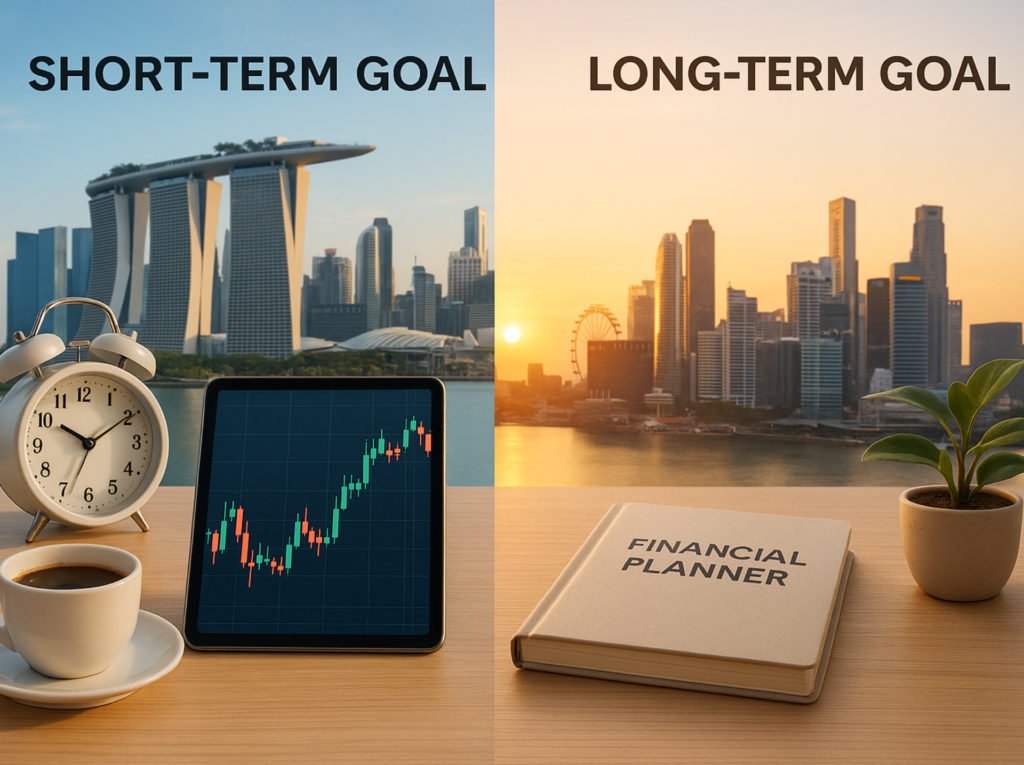Long-term goals (10+ years) focus on building wealth through growth and compounding returns. Think retirement, child’s education, or paying off a home loan. These allow for higher risk investments like stocks and ETFs.
Short-term goals (1-3 years) prioritize stability and liquidity for immediate needs like weddings, holidays, or emergency funds. Safer options include Singapore Savings Bonds, fixed deposits, and high-yield savings accounts.
Quick Comparison
| Feature | Long-Term Goals | Short-Term Goals |
|---|---|---|
| Time Horizon | 10+ years | 1-3 years |
| Risk Tolerance | Higher | Lower |
| Primary Objective | Wealth accumulation | Capital preservation |
| Liquidity | Limited | High |
| Typical Goals | Retirement, education, housing | Weddings, holidays, emergencies |
Tip: In Singapore, combine both strategies to balance growth and liquidity. Start early for long-term goals and use tools like SSBs or fixed deposits for short-term needs.
Long-Term Portfolio Goals Explained
What Makes Long-Term Goals Different
Long-term portfolio goals typically stretch over 10 years or more, focusing on growth while leveraging market recovery and the power of compounding returns.
With this extended time frame, investors can afford to take on more risk, which often means allocating a larger portion of their portfolio to growth-oriented assets like equities. Historically, equities have delivered returns that can help cushion against temporary market downturns.
Some common long-term financial goals include saving for retirement, building a fund for your child’s education, or paying off your HDB flat. These objectives require a substantial accumulation of capital over time, making systematic investment strategies particularly effective.
For instance, setting aside 15% of your income starting at age 25 can grow your retirement savings by up to 15 times. This highlights the importance of disciplined, long-term investing. Now, let’s explore how Singapore’s unique financial tools support these strategies.
Singapore-Specific Long-Term Planning
Singapore’s financial landscape offers distinct opportunities and challenges for long-term planning. With life expectancies rising to 82 years for men and 86 for women, Singaporeans need to prepare larger retirement funds that go beyond CPF savings.
The Supplementary Retirement Scheme (SRS) is one such tool that offers tax benefits while helping to grow retirement wealth. The increasing popularity of SRS accounts – rising from 289,000 accounts in 2021 to 427,000 in 2023 – reflects its value in long-term planning.
Another advantage in Singapore is the absence of capital gains tax on share profits, making the stock market a compelling option for equity investments aimed at long-term growth.
However, retirement preparedness remains a concern. A 2023 study found that only 34% of Singaporeans aged 53 to 73 feel confident about their retirement plans, while 27% do not have any retirement plan at all. These statistics highlight the importance of starting early to ensure financial security.
“Retirement is more likely to be a joyful milestone the earlier you make plans for it.” – DBS Singapore
For those interested in systematic investing, Singapore’s ETF market offers a diverse range of options. With 73 exchange-traded funds available, investors can build diversified portfolios, from local-focused ETFs like the STI ETF (ES3) to international options such as S&P 500 ETFs.
Investing in SGD-denominated assets removes currency risk, but achieving international diversification requires balancing Singapore’s stability with global growth opportunities.
“Staying invested, in our opinion, maximises the probability of investment success. The longer you are invested, the longer you benefit from the power of compounding.” – Standard Chartered Singapore
Short-Term Portfolio Goals Explained
What Makes Short-Term Goals Different
Short-term portfolio goals generally cover a timeframe of one to three years, focusing on immediate financial needs. Unlike long-term goals, which can weather market swings in pursuit of growth, short-term goals prioritise stability and easy access to funds. The emphasis here is on capital preservation rather than chasing high returns.
The main distinction lies in risk tolerance. If you need funds soon, market volatility can derail your plans. To avoid this, short-term strategies often lean towards lower-risk investments, even if it means settling for more modest returns.
Short-term goals often revolve around pressing needs like clearing debts, saving for a wedding, buying a car, or building an emergency fund. They can also include plans like funding a holiday or making minor home improvements. For these types of objectives, liquidity and safety take precedence over aggressive growth.
Take Carlos and his partner as an example. They’re planning their wedding in 2 years with a budget of S$24,000. To meet this goal, they each set aside S$500 monthly for the next 2 years. Similarly, Priya, who recently got promoted, is planning a trip to Japan in 8 months, requiring S$4,000. She’s saving S$500 a month by cutting back on dining out and entertainment.
When it comes to short-term savings, the calculations are different. For instance, reaching a S$10,000 target might take about 3 years and 9 months at a 5% interest rate, but it stretches to 4 years and 1 month at just 0.5%. The beauty of short-term goals is the quick feedback they provide – you can track your progress regularly, which can be motivating. Up next, let’s dive into some Singapore-specific tools that can help secure your short-term financial needs.
Singapore-Specific Short-Term Options
Singapore offers a range of financial tools tailored to short-term portfolio goals. These options strike a balance between accessibility, modest returns, and capital protection.
One popular choice is the Singapore Savings Bonds (SSB). Backed by the government, these bonds provide guaranteed returns and the flexibility to redeem them anytime after the first year without penalties. With yields typically ranging from 2% to 3% per annum, they’re a solid choice for conservative short-term planning.
Fixed deposits from banks like DBS, OCBC, and UOB are another reliable option. While their interest rates may vary with monetary policy, fixed deposits offer principal protection and predictable returns, making them ideal for short-term goals.
For slightly higher returns, money market funds are worth considering. These funds invest in high-quality, short-term debt instruments such as bonds and Treasury bills, offering a low-risk way to grow your savings.
The Central Provident Fund (CPF) Ordinary Account is another option that offers a 2.5% annual interest rate. While funds in this account aren’t freely withdrawable, they provide a stable foundation for building financial security.
High-yield savings accounts also deserve a mention. They offer competitive interest rates combined with full liquidity, making them perfect for emergency funds or other short-term savings goals.
According to a recent poll by Singlife, only 55% of Singaporeans feel confident about achieving financial freedom. The survey also revealed that participants believe they need around S$612,000 in cash to feel financially secure – an 8% rise from S$566,000 in 2023. This highlights the importance of starting with manageable short-term goals before aiming for larger financial milestones.
For those seeking more diversity, exchange-traded funds (ETFs) focused on bonds or money market instruments are another avenue. Singapore’s ETF market features 73 options, including several that cater to conservative, short-term strategies.
Additionally, Singapore’s lack of capital gains tax makes short-term trading more appealing compared to other markets. However, this approach requires expertise and carries higher risks, which may not align with most short-term financial objectives.
“Risk comes from not knowing what you’re doing.” – Warren Buffet
This quote is particularly relevant to short-term investing, where the focus should always be on preserving your capital rather than chasing high returns. By understanding your options and their risks, you can ensure your short-term financial goals stay on track and within reach. With the right strategies, short-term planning can complement both immediate and long-term financial aspirations.
Long-Term vs Short-Term Goals Comparison
Benefits and Drawbacks of Each Approach
When comparing long-term and short-term investment strategies, it’s essential to weigh the benefits and challenges of each. By understanding these trade-offs, you can make more informed decisions about your financial goals.
Long-term investing is a powerful tool for building wealth. Over time, the magic of compounding can significantly grow your investments, and you’re better equipped to ride out market downturns. However, this approach ties up your funds for years, limiting liquidity when you might need cash quickly. There’s also the risk of company-specific issues impacting your portfolio. On the plus side, long-term strategies require less daily involvement, which is perfect for those with busy schedules.
On the other hand, short-term investing offers faster returns and greater flexibility. It allows you to take advantage of market trends, news events, and price movements to generate quick profits. This approach is ideal for those who need liquidity for immediate expenses or want to adapt quickly to changing market conditions. But it’s not without its challenges – frequent trading leads to higher costs, increased exposure to market volatility, and the emotional stress of constant monitoring. In Singapore, high-frequency trading could also attract tax implications if it’s classified as business income.
Inflation protection is another area where these strategies differ. Long-term investments generally provide better protection against inflation due to their potential for higher returns. In contrast, short-term investments often struggle to keep up with rising costs.
Side-by-Side Comparison Table
To give you a clearer picture, here’s a breakdown of how long-term and short-term goals stack up:
| Feature | Long-Term Goals | Short-Term Goals |
|---|---|---|
| Time Horizon | 10+ years | Under 3 years |
| Primary Objective | Wealth accumulation and capital growth | Preserving capital and ensuring liquidity |
| Risk Tolerance | Higher | Lower |
| Potential Returns | Higher | Lower |
| Investment Types | Stocks, mutual funds, REITs | CDs, money market accounts, government bonds |
| Liquidity | Limited | High |
| Exposure to Market Risks | Can endure market fluctuations | Focus on lower-risk options |
| Time Commitment | Minimal daily involvement | Requires active monitoring |
| Transaction Costs | Lower due to infrequent trades | Higher due to frequent transactions |
| Typical Goals | Retirement, wealth building, children’s education | Weddings, holidays, emergency funds |
| Inflation Protection | Better due to higher returns | Limited |
| Emotional Stress | Lower stress, less daily worry | Higher stress from constant market watching |
Your choice between these approaches will largely depend on your goals and circumstances. For example, if you’re a working professional focused on retirement savings, a long-term strategy may suit you best. But if you’re saving for something like a wedding or an upcoming holiday, short-term investing is likely the better fit.
Many investors in Singapore prefer a balanced approach, combining long-term investments with short-term opportunities. This hybrid strategy allows you to enjoy the benefits of both while managing the risks associated with each. By aligning your investment timeline with your goals and risk tolerance, you can create a more effective financial plan.
Singapore’s status as one of the world’s most competitive economies and a leading financial hub offers a fertile ground for both strategies. The country’s strong regulatory framework and diverse investment options provide the flexibility to tailor your approach, whether you’re focusing on long-term wealth or immediate financial goals. This comparison sets the stage for integrating more structured trading strategies into your portfolio.
Short-Term Investing vs Long-Term Investing Explained
sbb-itb-466c9b0
Master Systematic Trading with Collin Seow
Learn proven trading strategies, improve your market timing, and achieve financial success with our expert-led courses and resources.
Using Systematic Trading for Portfolio Goals
Systematic trading brings a structured, data-driven approach to investing, steering clear of emotional decisions and gut instincts. By relying on algorithms and quantitative analysis, it helps investors make objective choices that align with both long-term and short-term portfolio strategies.
What makes systematic trading so appealing is its flexibility. Whether you’re planning for retirement or aiming to capitalise on short-term market movements, this method can be tailored to fit your specific goals and risk tolerance. It’s no wonder professional traders and institutions worldwide manage hundreds of billions of dollars through systematic strategies.
Systematic Trading for Long-Term Goals
When it comes to building wealth over the long haul, systematic trading provides a disciplined framework for navigating sustained market trends while managing risk. By combining technical and fundamental analysis, it offers a well-rounded perspective on potential price movements.
Historical data supports the effectiveness of this approach. For example, between 1950 and 2021, the S&P 500 saw most of its gains during the November to April period, while the May to October period was relatively flat. A case in point: an investor who systematically held S&P 500 positions from 1991 to 2000 walked away with a profit of S$16 million. Similarly, disciplined long-term investments in stocks like Motorola have showcased the value of sticking to a systematic plan.
One key tool for long-term success is backtesting. By analysing historical performance, traders can identify weaknesses and refine their strategies before putting real money on the line. For Singapore-based investors, applying diversified strategies across the Singapore Stock Exchange (SGX) and international markets can help balance risks while tapping into growth opportunities.
Systematic Trading for Short-Term Goals
Short-term trading is all about seizing immediate opportunities in the market, and systematic methods can make this process more efficient and less stressful.
This approach focuses on quick profits while prioritising capital protection. It requires constant monitoring and fast decision-making, but systematic trading removes much of the emotional burden that often accompanies active trading. Tools like moving averages, chart patterns, and momentum indicators are commonly used to determine the best entry and exit points. Rigorous risk management techniques, such as sell stops and buy stops, help limit losses and let profits run.
A standout example from Singapore is a local remisier who used the TradersGPS system to clear a S$250,000 debt in just 16 months. Professional trader Gareth Chin shared how systematic trading transformed his approach:
“In the past I have been trading by price action. So this is giving me an alternative to look into systematic trading method…”
Another success story comes from financial advisor Gunawan, who recounted:
“at that time I challenged the trainer to select the stock…, within one week it creates 40% of return… and it is enough for me to cover the initial investment (courses fee)”
Learning Resources and Education
To excel in systematic trading, a solid understanding of technical analysis and risk management is essential. Resources like those offered by Collin Seow Trading Academy can provide the foundation you need. Their programmes include the Market Timing 101 E-Course, which focuses on precision in buy and sell decisions, and the Systematic Trading Profits programme, a three-phase system designed to build trading expertise.
The academy emphasises removing emotions from trading by relying on data-driven methods. Tools like the book The Systematic Trader v.2, live webinars, and mentorship sessions help traders develop the discipline required for success. For Singapore traders, these resources are particularly valuable as they address the unique dynamics of the SGX and regional markets, giving local investors an edge in crafting effective strategies.
While systematic trading does carry risks, proper education can significantly shorten the learning curve. With the right training and tools, traders can confidently apply systematic methods to both long-term wealth-building and short-term profit strategies.
Conclusion: Picking Your Portfolio Goals
Key Takeaways
Deciding between long-term and short-term portfolio goals boils down to your risk tolerance, time availability, and financial objectives. If you’re looking for stability and the benefits of compounding, long-term investing might be your path. On the other hand, if you’re comfortable navigating market ups and downs, short-term trading could be more appealing.
In Singapore, the absence of capital gains tax makes long-term investing especially appealing. However, frequent trading might be treated as business income and taxed at personal rates, so it’s important to understand how your trading activities could be classified.
Compounding can have a massive impact over time. For example, an additional 2% annual return over 30 years could lead to 50% more capital. As Freddy Lim, Co-founder of StashAway Singapore, explains:
“Putting a timeline and goal amount for your investments matters because the strategy you take to invest for the long term is very different than if you are investing for the short term.”
Some traders find success by combining strategies – building wealth through long-term investments while taking advantage of short-term market movements. Each approach requires its own skill set: long-term investing relies on fundamental analysis, while short-term trading leans heavily on technical analysis.
These insights provide a foundation for actionable steps tailored to Singapore’s trading environment.
Practical Steps for Singapore Traders
Start by evaluating your current situation. Ask yourself: Do you have the time to actively engage in short-term trading, or would you prefer the hands-off nature of long-term investing? Your strategy should match your financial goals, whether it’s saving for retirement or achieving quicker returns for immediate needs.
For context, surveys in Singapore show that many individuals feel they need around S$612,000 in cash to achieve financial freedom, up from S$566,000 in 2023. This highlights the importance of setting realistic and personalised financial targets.
If systematic trading piques your interest, focus on defining clear objectives, crafting a strategy based on market opportunities, and backtesting it with historical data. A structured, data-driven approach can help you make more consistent decisions.
To deepen your knowledge, consider resources like Collin Seow Trading Academy. Their Market Timing 101 E-Course and Systematic Trading Profits programme offer practical training for both long-term and short-term strategies, emphasising the importance of removing emotional bias through data-driven methods.
Lastly, make it a habit to review your goals annually or after major life changes. As markets shift and your personal circumstances evolve, staying informed about economic trends can help you adjust your strategy to stay aligned with your financial aspirations.
FAQs
How can I effectively combine long-term and short-term investment strategies to meet my financial goals in Singapore?
To blend long-term and short-term investment strategies effectively in Singapore, start by pinpointing your financial goals and the timeframes attached to them. For instance, if you’re saving for a car or a holiday, you might prioritise safer, liquid options. On the other hand, goals like retirement or buying property often call for investments geared towards growth.
A well-rounded strategy could involve long-term investments such as stocks, REITs, or ETFs to build capital, alongside short-term options like fixed deposits, bonds, or cash-equivalent assets for stability and easy access to cash. Regularly reviewing your portfolio is key – it keeps your investments aligned with any shifts in your goals or Singapore’s financial environment, ensuring you stay on course.
What are the tax differences between short-term trading and long-term investing in Singapore?
Tax Implications of Trading and Investing in Singapore
In Singapore, there’s no capital gains tax, which means profits from both short-term trading and long-term investing are generally untaxed. However, things can get a bit tricky if your trading activity is frequent enough to resemble a business. In such cases, the profits might be treated as taxable income. This scenario is more common with short-term trading, where transactions happen more regularly.
On the other hand, long-term investing typically doesn’t attract any tax liability on profits. Plus, holding onto investments for a longer period can help reduce transaction costs. Singapore’s tax system tends to favour long-term strategies because of these minimal tax implications. Still, it’s essential for traders to understand how their activities might be viewed under the tax regulations to avoid any surprises.
What are the advantages of systematic trading for achieving both long-term and short-term portfolio goals?
Systematic trading offers a range of benefits that cater to both short-term and long-term investment objectives. By sticking to a clear set of rules, it promotes consistent decision-making, helps keep risks under control, and minimizes the impact of emotions on trading actions.
For short-term targets, this method enables traders to react swiftly to market fluctuations. On the other hand, for long-term goals, it supports backtesting, allowing traders to assess the effectiveness of strategies over extended periods. This organised approach helps maintain discipline and enables better-informed choices, no matter the investment timeframe.












